Table of Contents[Hide][Show]
A nourishing homemade baby formula using safe, whole ingredients. This recipe was developed and tested by Dr. Mary Enig, a PhD Nutritionist and originally published in Nourishing Traditions cookbook in 1996. It was formulated to match breastmilk as closely as possible and is also suitable for infants. Source: Weston A. Price Foundation
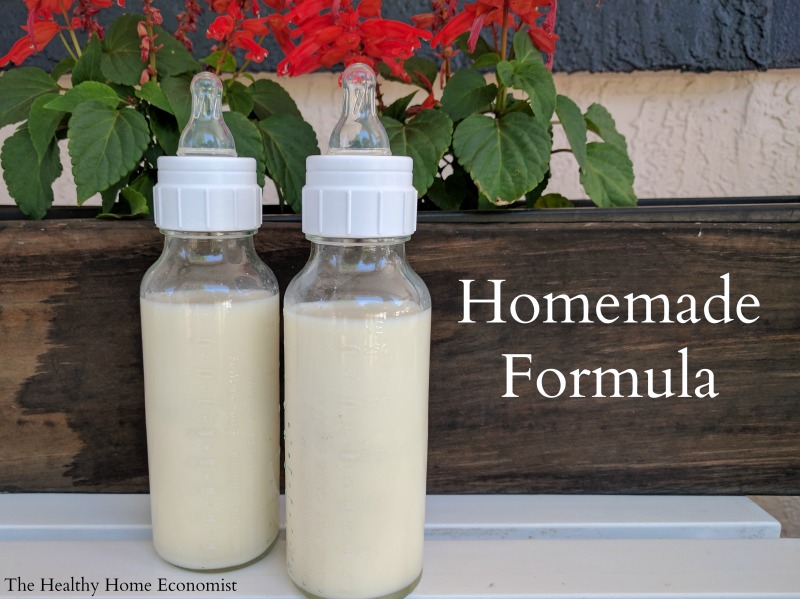
There is no doubt that breastfeeding your baby is the best option for the child’s long-term health and development. Human breastmilk from a well-nourished mother is the perfect food for baby. However, in circumstances where the child is adopted or the Mother finds herself unable to breastfeed, formula feeding becomes necessary. In those cases, homemade baby formula is best.
Using a baby formula recipe that closely matches the nutritional profile of breastmilk is a far better choice than even organic baby formula from the health food store. More on this below.
Note: Donor programs are widely available for human breastmilk. But, the diets of the donor mothers are unknown and most likely nutritionally insufficient. In addition, breastmilk banks pasteurize the donated breastmilk which destroys much of the nutritional benefit. Unless you are fortunate to have a trusted and direct donor milk source in your community, avoid this option!
Dangers of Commercial Formula
Commercial formulas are always a poor choice for a number of reasons. First of all, formula manufacturers line the cans with the chemical BPA. This substance disrupts hormone development and is a probable contributor to early puberty in girls, and ADHD, urogenital abnormalities, and other ills in boys.
The European Food Safety Authority found that canned commercial formula is a significant source of BPA for infants, exposing the child to 13mcg of BPA per kg of body weight per day! BPA-free formula cans are no better. The chemical BPS is typically used instead which is just as dangerous.
Beware that manufacturers pack even organic commercial formula like Earth’s Best in BPA cans. Worse, they use organic brown rice syrup as the primary sweetener which is known to be frequently contaminated with arsenic.
In addition, all commercial milk formulas are processed at extremely high temperatures which violently denature the fragile milk proteins, render them allergenic, and add carcinogens to the final product. Soy infant formula is the worst. Obscenely high processing temperatures not only denature the proteins but large levels of phytic acid in soy block mineral absorption by the infant. Moreover, soy-based plant estrogens disrupt the hormonal development of the baby!
It seems that for the concerned Mother who is unable to breastfeed, learning how to make baby formula at home with safe, pure ingredients is the most prudent way to go!
Why Make Homemade Formula Even if You Are Breastfeeding
In the video below, I show you how to make your own safe, healthy raw milk homemade formula for your baby.
The recipe I follow was originally published in the cookbook Nourishing Traditions in 1996 and developed by Dr. Mary Enig.
Even though I breastfed each of my children for at least 2 years, I made this exact formula for my own children when I was away for the day or the evening as pumping was not an option that worked well for me.
I even used this homemade formula for an entire day once when I had some dental work done and was advised to pump and discard for 24 hours.
As a result, even successfully breastfeeding Moms can use this wonderful homemade formula as a supplement when necessary to their own nutrient-dense breastmilk!
It is advised that even breastfeeding Mothers have the ingredients for this formula on hand for an emergency. If Mom is sick or otherwise unable to nurse, Dad can step in and make this safe alternative until Mom is back on her feet. It takes a few days to a week to gather all the ingredients together to make this formula, which is why I advise having them on hand at all times.
Homemade Most Nutritious
The image below lists the reasons why it is worth it nutritionally to make formula yourself for your precious baby!
You can order all of the required ingredients for the homemade baby formula in one package from this reputable, vetted source.
Moms who have successfully used this formula feeding your children, please post about your experience in the comments section to encourage those who are considering it and need some Mom to Mom encouragement!
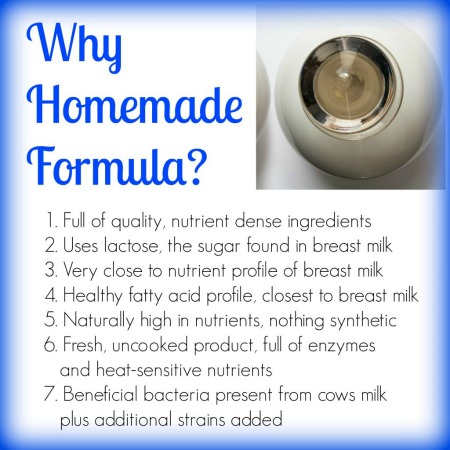
Where to Source Quality Milk
The most widely available grass-fed milk around the world is from cows. This is usually the most budget-friendly and easily sourced milk for this recipe for homemade formula.
If only goat milk is available in your area, this recipe for goat milk baby formula can be used instead. When using milk from ewes, please refer to the linked article for an adjusted recipe; one of the benefits of sheep milk is that it is higher in healthy fats than either goat or cow milk.
Camel milk formula is another option that is a particularly digestible form of dairy and growing in popularity around the world.
Alternatively, you can use low temp (vat) pasteurized, non-homogenized whole milk cultured with a piima or kefir starter. Then substitute the piima milk or kefir for the raw milk portion of the formula recipe. Cold-pressed raw milk also must be cultured before using it as it contains no probiotics.
Do NOT use ultrapasteurized (UHT) milk even if organic as it is too highly processed and extremely allergenic!
It is also best to avoid all types of powdered milk for this recipe. The factory process of making milk powder reduces nutrition considerably and denatures it, which makes it more likely baby will have an allergic reaction.
Dairy Allergy Option
If all types of dairy prove unsuitable for your baby, make this nondairy baby formula recipe instead. It uses a base of homemade bone broth as a substitute for milk. It is important not to utilize a plant-based or otherwise vegan baby formula recipe.
Avoid buying bone broth to make the dairy-free formula. Make it yourself! Manufacturers of commercial bone broth, even if authentic, may water down the end product. This is apparent if it does not gel when chilled in the refrigerator.
Many brands have toxic packaging issues as well. If you must buy it in a pinch, see my shopping guide page for vetted brands that are safe.
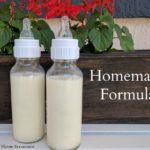
Homemade Baby Formula Recipe (for infants too)
A nourishing baby formula recipe you can make at home with safe, whole ingredients developed and tested by a PhD nutritionist to match breastmilk as closely as possible. Also suitable for infants.
Ingredients
- 2 cups raw cow milk OR organic whole milk yogurt
- 1 7/8 cups filtered water
- 1/4 cup liquid whey
- 4 Tbl lactose
- 1/4 tsp Bifidobacterium infantis powder
- 2-4 Tbl raw or pasteurized cream
- 1/2 tsp cod liver oil unflavored
- 1/4 tsp butter oil unflavored
- 1 tsp sunflower oil preferably organic
- 1 tsp extra virgin olive oil preferably organic
- 2 tsp virgin coconut oil preferably organic
- 2 tsp nutritional yeast
- 2 tsp gelatin
- 1/4 tsp acerola powder
Instructions
-
Fill a 2 cup Pyrex measuring cup with filtered water and remove 2 TBL (this will give you 1 7/8 cup water).
-
Pour about half the water into a pan and turn burner on medium.
-
Add the gelatin and lactose and let dissolve, stirring occasionally.
-
When gelatin and lactose are dissolved, remove pan from heat and add the rest of the water to cool.
-
Stir in the coconut oil and butter oil until melted.
-
Put remaining ingredients in a glass blender.
-
Add the water mixture and blend for about 3 seconds.
-
Place formula in glass baby bottles or a glass jar and refrigerate.
-
Before giving to baby, warm glass bottle in a pan of hot water or a bottle warmer. NEVER microwave baby bottles!
Recipe Video
Recipe Notes
If using raw cow milk from holstein cows, use 4 Tbl of extra cream (otherwise use 2 Tbl extra cream).
If choosing to make this homemade formula with camel milk, be sure to include 4 Tbl extra cream as camel milk is lower in cream than cow milk.
Do not use high oleic sunflower oil. Use only the brand recommended in the ingredients list which is cold pressed, organic, unrefined, and low oleic.
*Do NOT use powdered whey from the store as it is denatured. Avoid whey from making cheese as it will curdle the formula.
*Do not substitute pasteurized or powdered milk as these are heavily processed, denatured and allergenic foods.
*Do NOT use ultrapasteurized (UHT) cream. It is highly allergenic. Raw or pasteurized cream is acceptable.
*Do NOT use fish oil or krill oil instead of high vitamin cod liver oil as they do not contain any Vitamin D and very little to no Vitamin A.
Collagen powder may be substituted for the gelatin in a pinch (more on peptides in baby formula in this article).
If you are wondering where is the iron in homemade baby formula, this article provides an explanation.
If baby experiences constipation using this formula, try adding 1 tsp of molasses to each batch. This should help move things along.
How to Transition to DIY Formula
Once you’ve viewed the video, gathered the ingredients, and made your first batch, how do you feed it to your baby for the first time?
It is important not to switch all at once as this can cause gas, excessive spit-up, or an uncomfortable change in diaper habits such as constipation or overly loose stools.
Start by giving your baby three-quarters of the old formula blended with one-quarter of the homemade. Try this ratio for a day or two and see how your infant responds.
If no digestive upset or major change in diaper habits occurs, increase the amount to a 50-50 blend of old formula to homemade. Observe for another day or two as before.
If no major issues, increase once again to three-quarters homemade formula to one-quarter old formula. If baby does well on this blend for a third time, you are ready to fully transition to the homemade formula.
At any time during the transition, symptoms of intolerance emerge, back up to the previous successful blend ratio and stay there for a day or two before attempting to increase once again.
Homemade Formula FAQ
Weston Price Foundation
Feeding an Adopted Baby
Traveling Tips with Baby Formula Made at Home
Iron in Baby Formula
Collagen Peptides instead of Gelatin for Homemade Formula?


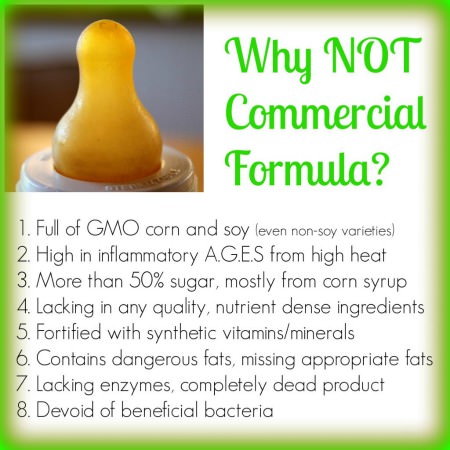
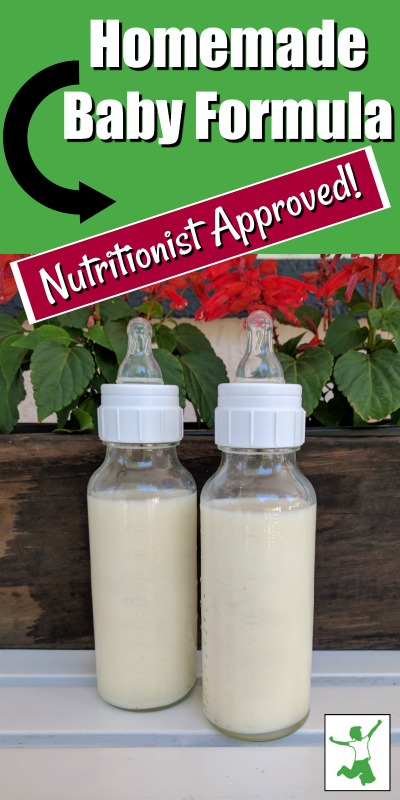






Thank you for your reply Sarah.
Hi Sarah, my cousin has a 1 year old and a 2 year old, and she was wondering if she can give her children this formula for added nutrients in their diet. My cousin stated that they are very slim and are picky with the milk they drink, so she asked me about this milk. I know it’s recommened until 1 year, but I thought I’d ask. Thank you in advance.
If the child isn’t eating enough food after age one … consult with a doctor to figure out what is going on. This formula is designed for the nutritional needs of a child less than age one, not toddlers.
I have made the recipe twice now and each time the formula gets thick like yogurt when I put it in the refrigerator! What am I doing wrong?
You’re not doing anything wrong. It’s just the gelatin in the formula solidifying. It will re-liquefy when you warm up some for a bottle.
Hi Sarah, thank you for your reply 🙂 I’m still a little confused with one of your answers. Maybe I didn’t ask the question correctly. After I blend all the ingredients in the blender, there is always foam on top. I always wait a few minutes before pouring formula in glass bottles so the foam stays behind and doesn’t pour in the bottles. Is it fine that I’m leaving the foam behind? Thank you
Yes, that’s fine.
I’ve been making the raw milk formula for about 1 month. My baby loves it and is no longer constipated. Thank you for the recipe. I’m glad I found it online.
I have a few questions hoping you can answer.
1.) After I blend all the ingredients, there is always a thick foam cream at the top. I always wait a couple minutes then pour liquid, leaving the foam cream behind. Is that normal?
2.) I purchase raw milk and raw cream at Sprouts. Not sure if you’re familiar with store. Anyway, the raw cream is “heavy” raw cream. That’s what it states on the bottle. How many tablespoons is good to use with heavy raw cream?
3.) If in one sitting, baby doesn’t drink entire milk in bottle, is it okay to recycle milk for next feeding?
4.) I read that heating raw milk loses its enzymes. Is the baby getting his full nutrients despite milk being heated?
Hi Cathy 🙂
In answer to your questions, foam on the cream is normal and leaving some behind when you pour is ok.
The amount of cream in the recipe is for heavy cream.
It is not a good idea to reuse the milk the baby doesn’t drink.
When you heat the bottle, it is not hot enough to destroy the hugely beneficial raw milk enzymes, probiotics, and immunofactors.
Thank you for such an informative and awesome recipe. I have Hipp formula that I bought and need to use, do you think I could just add a few of these ingredients to make it a bit better? Thank you
This formula was designed by a PhD nutritionist to be made and used as directed. Do not selectively add ingredients to commercial formulas or modify any other way than as described in the recipe.
In NC I can not find many farms that sell raw cows milk “legally for human consumption” is that normal?
Most farms say it is not sold for human consumption is that just a general statement they have to make on their raw milk products?
Also if I can find raw milk to create my liquid whey, what can I use as a substitute for liquid whey?
Lastly, I am considering not vaccinating my children is there an additive that is safe for babies that I could include in this natural formula that would help prevent disease and sickness and increase their immune system?
North Carolina has a law where raw milk is legal for animal consumption. It is the same here in FL. In South Carolina, it is legal for human consumption and apparently sold in some stores. You can drive across the border and get some there or assess your raw milk farm in NC and if it has a good track record, use it from your home state.
I’m needing to supplement my newborn about an ounce per feeding. How long will the formula keep in the fridge? Can i freeze ice cube sized portions and thaw for feedings or should I make half batches? Thank you!
Yes you can freeze ice cube portions and thaw for feedings.
Hello! I love this formula, however lately it has been chunky after I put it in the refrigerator.
It’s as if the gelatin chunks the entire thing.
The raw milk I use is new and it doesnt smell bad.
Not sure what is happeneing??
Yes, it will solidify a bit due to the gelatin and coconut oil in the refrigerator. Everything will reliquefy when you warm some up for a bottle.
Thank you, once again, for your reply! One more question: I noticed that the particular brand used for the formula for acerola powder includes “non-GMO Maltodextrin” in the powder. Ideally we’re trying to avoid maltodextrin altogether, so we’re wondering if there is a nutrition-related reason why this type of acerola powder is preferred over one that does not have maltodextrin (be it non-GMO or not), such as the one offered by ‘Super Good For You Foods’ (which is freeze dried)?
The brand of acerola recommended is suggested because the amount in the formula recipe is based around the mg of Vitamin C per serving for that particular brand. If you look at other whole food vitamin C on the market, they vary in mg per serving.